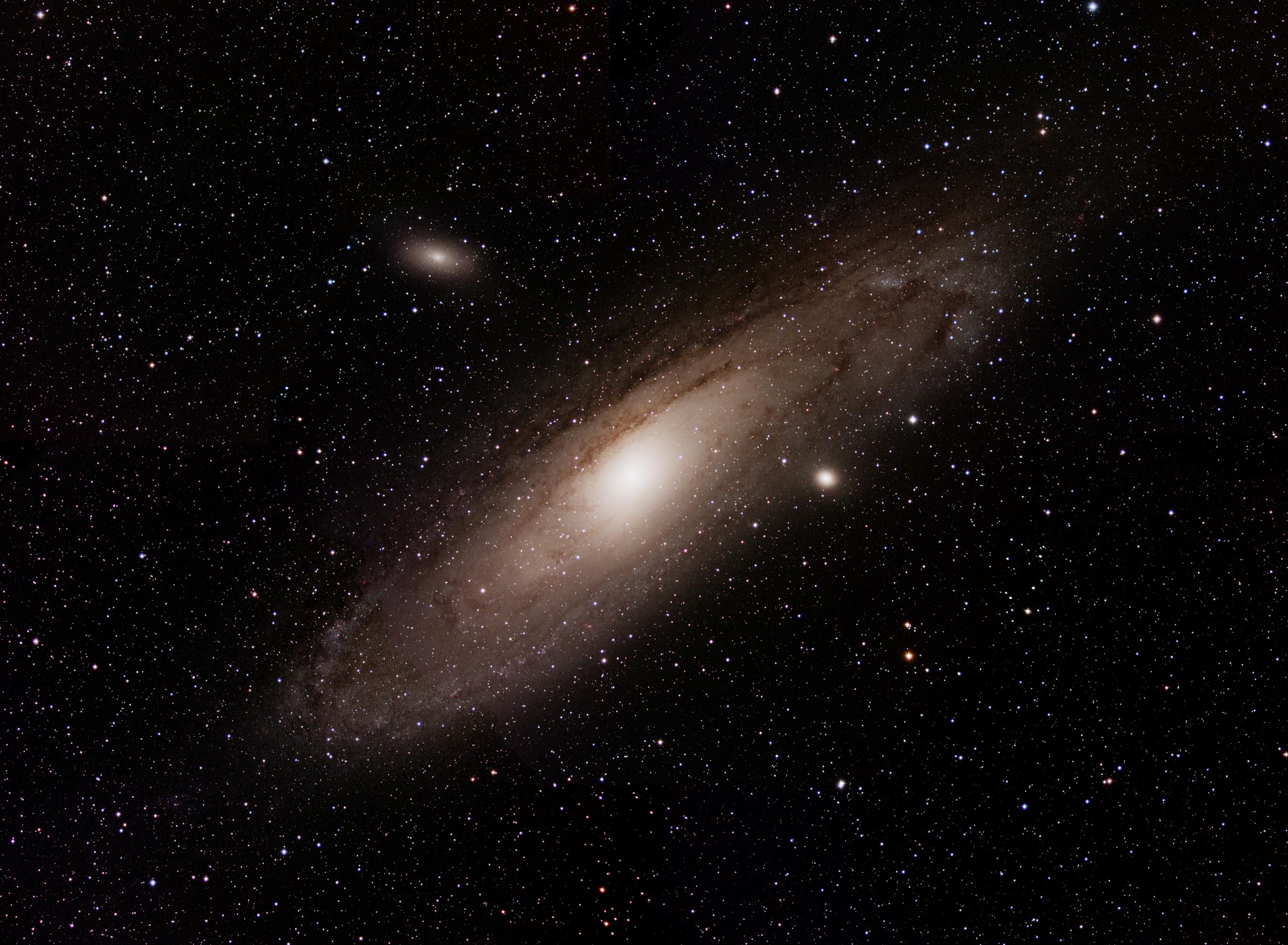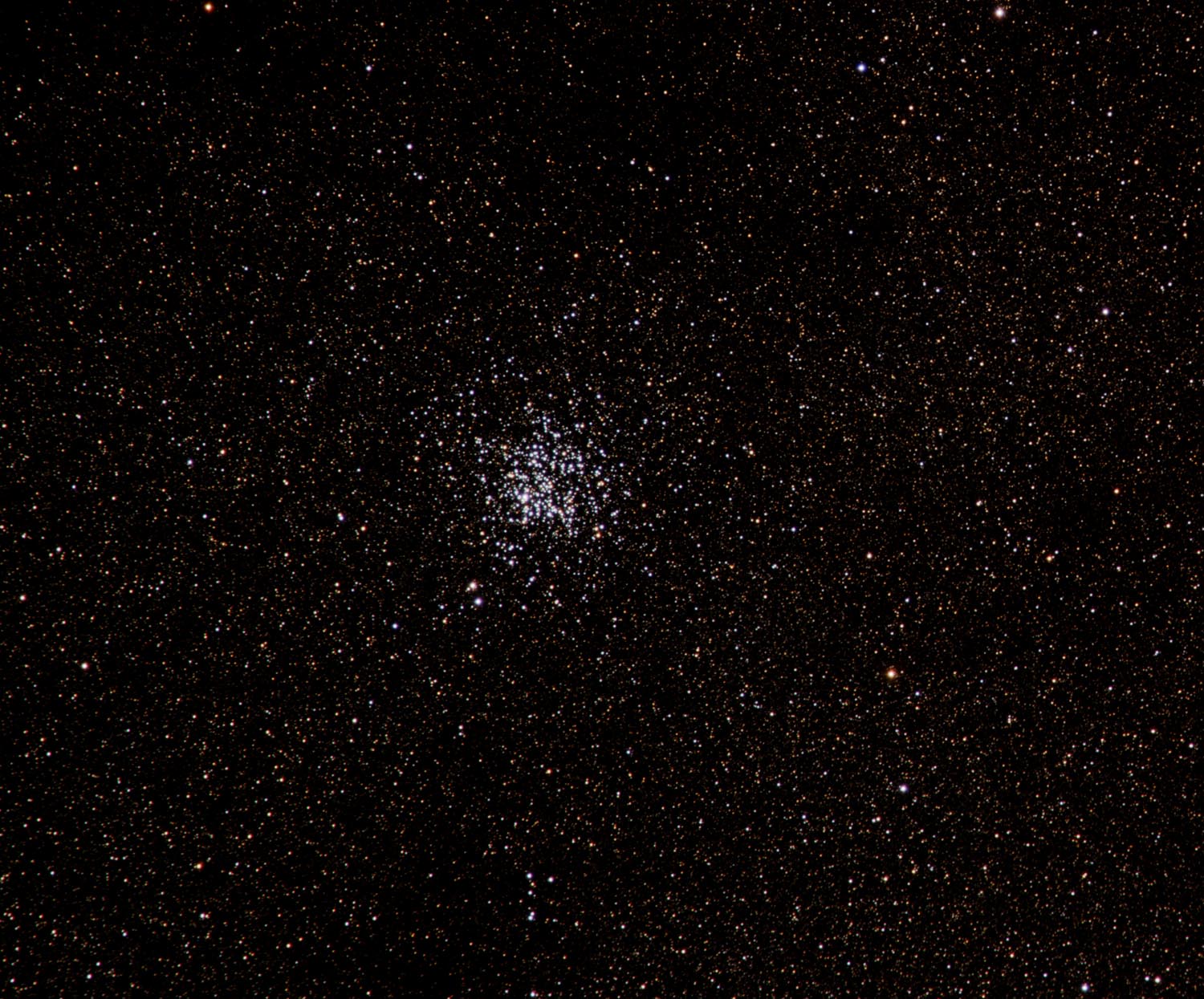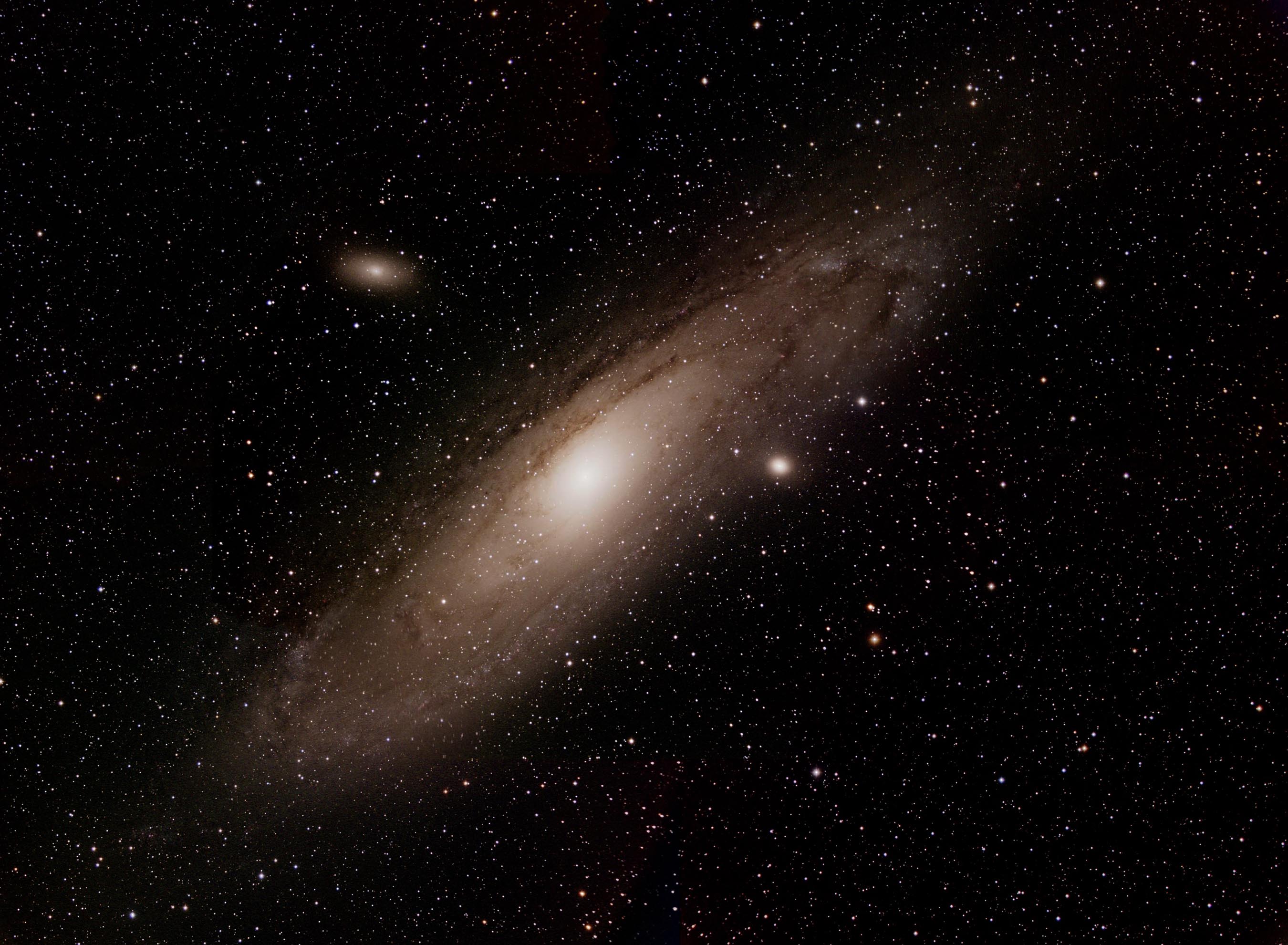
 | SOCO Blog |
10 November 2016
THE BLUES
Fall is here and that means that the great Andromeda Galaxy (M 31) is floating high overhead in the evening sky. I have imaged this object several times in the past, with one of the most recent efforts being described in my blog entry of 26 January 2016. In that entry, I present a mosaiced image of the galaxy developed from imagery acquired in September of 2014. This image is shown below as Figure 1.

Figure 1. The Andromeda Galaxy (M 31), imaged in September of 2014.
I think this is a great true-color image, showing the galaxy glowing in a creamy brown hue that is the combination of older, redder Population I stars and brownish interstellar dust bands in the galactic disk. Galaxies like M 31 also contain younger, blue-ish Population II stars scattered along the spiral arms. These stars have formed more recently from condensed clouds of hydrogen gas ("HII regions") that trace the spiral structure of the galaxy. These are readily visible in spiral galaxies such as the Triangulum Galaxy (M 33). In my image of M 31, these groups of Population II stars are just hinted at by the light blue-ish patches near the outer border of the disk, primarily in the southern portion of the galaxy (the upper left corner in my image). The brightest of these patches has the designation NGC 206.
In looking at other sources, I have noticed that some images of M 31 show a distinct "halo" of blue-ish stars around the outer circumference of the galaxy. The picture on page 156 in Sue French's great book Celestial Sampler (Sky Publishing, 2005) is a good example. Most of the galaxy in that picture looks pretty much like mine, except for the addition of this halo of blue-ish stars. So, my question is, why is my image missing this feature?
A likely explanation has to do with what the Earth's atmosphere does to light trying to pass through it. The gases and aerosols in our atmosphere are good at sacattering and absorbing light passing through them. In the visible wavelengths, the atmosphere is most effective at scattering blue light. That's why the sky is blue on a clear day. When the sun is on the horizon, it appears red or orange because most of the blue light has been scattered out of the solar beam. The sun is overwhelmingly the brightest star in the sky, so it's solar beam contains a lot of blue light. What about the stars that we see at night? As shown in my image of the open cluster M 11 (Figure 2), the brighter blue-white stars can retain their color despite atmospheric scattering. However, you can notice that the smallest background stars in the image are reddened. While some of this loss of blue light can be attributed to absorption by interstellar dust, much of the loss results from atmospheric scattering.

Figure 2. The open cluster M 11 in the constellation Scutum.
In processing my "true color" images from red, green and blue master images (see my discussion of Weight Factors), my strategy to correct for atmospheric scattering is to apply correction factors to the red, green and blue master images to adjust them for the relative amounts of scattering. For example, for an object that is approximately overhead, the ratios of the correction factors for the red:green:blue wavebands would be roughly 1:1:1.2. In other words, the digital count values in the blue image would need to be increased by around 20% to compensate for scattering of blue light.
This approach seems to work well for the brighter stars in an image. However, there still may be a problem for the dimmer stars in the image (like the background stars in Figure 2). The photon fluxes for the dimmest stars may be so small that practically all the blue light gets scattered out before it reaches my telescope on the ground. This can be apparent in the master images, where the dimmest stars present in the red and green master images don't even show up in the blue master image. So, if there's nothing there in the blue master image, multiplying it by a correction factor is not going to help (i.e., zero multiplied by any number is still zero). This might be what's happening to many of the Population II stars in my image of M 31 (Figure 1). Since the stars in M 31 are so far away, their photon fluxes are going to be small. Thus, I may be losing practically all the blue light from these stars, and using a correction factor on them won't help.
In this approach, all the images are exposed for the same amount of time. A possible alternative approach would be to expose the images used to create the blue master image proportionately longer than the images used to create the red and green master images. In this way, the blue images would theoretically collect more light, which could compensate for some of the light lost through scattering. Hopefully, the dimmer stars would not be completely lost from the blue master image. When processed, correction factors would not need to be applied to the master images.
On the nights of 29 and 30 October 2016, I used this alternative approach to acquire new imagery of M 31. To create Figure 1, individual red, green and blue images were exposed for 4 minutes each. For this new set of imagery, I exposed the red and green images for 4 minutes but increased the exposure time for the blue images to 5 minutes. This represents an increase in exposure time of 25%, which is close to what might correspond to the previously described correction factor of 1.2. Processing of the imagery was the same as the previous case, except that no correction factors were applied to the master images. Results of this effort are presented in Figure 3.

Figure 3. The Andromeda Galaxy (M 31), imaged in October of 2016 using the alternative approach.
Unfortunately, there's not much difference between Figure 1 and Figure 3. The alternative approach was not successful in bringing out the blue-ish Population II stars in the galaxy. What this probably means is that the blue light from these distant stars is essentially completely lost before it reaches my telescope, so that exposing for a longer period of time still doesn't capture enough of it (i.e., there's nothing there to capture). Maybe exposing for an extremely long time might capture a few blue photons making it through the atmosphere, but it's probably not worth the effort.
So, how are other astronomers successful in capturing these blue stars? One key would be to reduce the amount of atmosphere that the photons have to try to pass through. SOCO sits at an elevation of around 3000 ft above sea level, which puts it underneath a large portion of the atmosphere. But the higher in elevation you get, the less atmosphere you have to look through. Above 7000-8000 feet, there's quite a bit less atmosphere above you to scatter light. That's why research observatories are built on the tops of mountains like Mauna Kea. In the high mountains around the Atacama Desert in Chile, there's so little atmosphere above you that you can effectively image even in infrared wavelengths (also, you may have to use oxygen equipment to breathe!).
So, for those of us with observatories at relatively low elevations, we're just going to have to accept the fact that we may miss out on some of the glory of certain astronomical objects. Still, this was a very useful experiment for me, since it showed that the current approach that I'm using is about as good as I can get under the circumstances.
 Return to SOCO Blog Page
Return to SOCO Blog Page
 Return to SOCO Main Page
Return to SOCO Main Page
Questions or comments? Email SOCO@cat-star.org